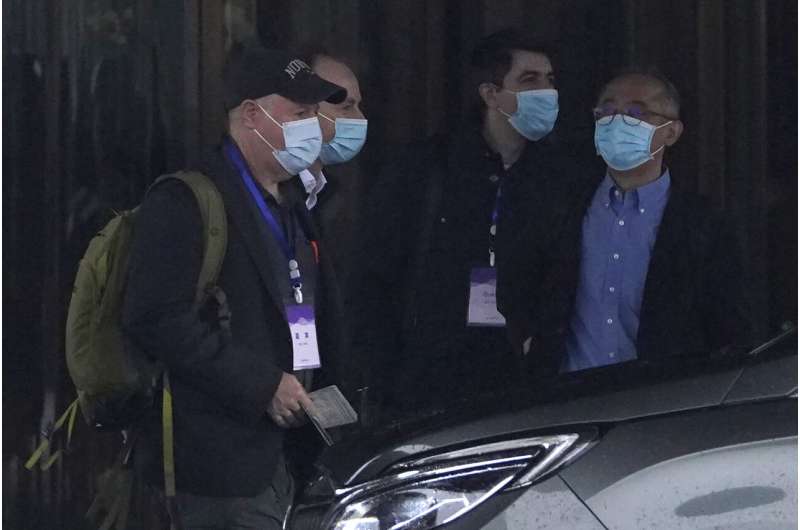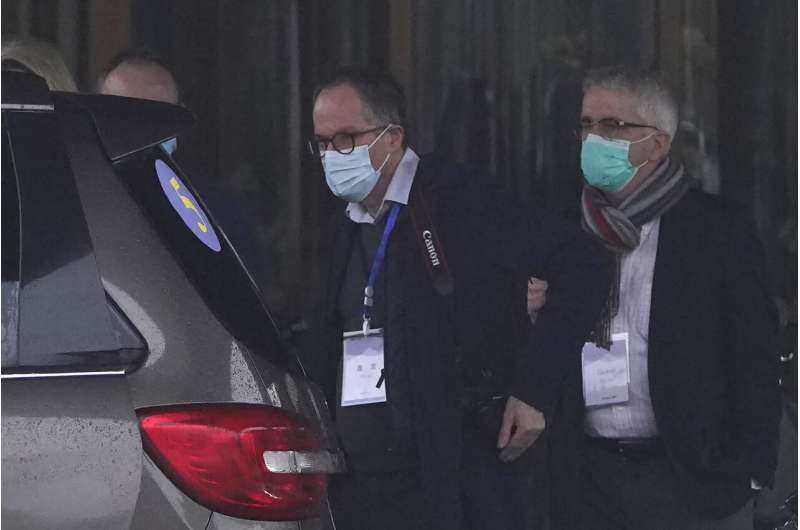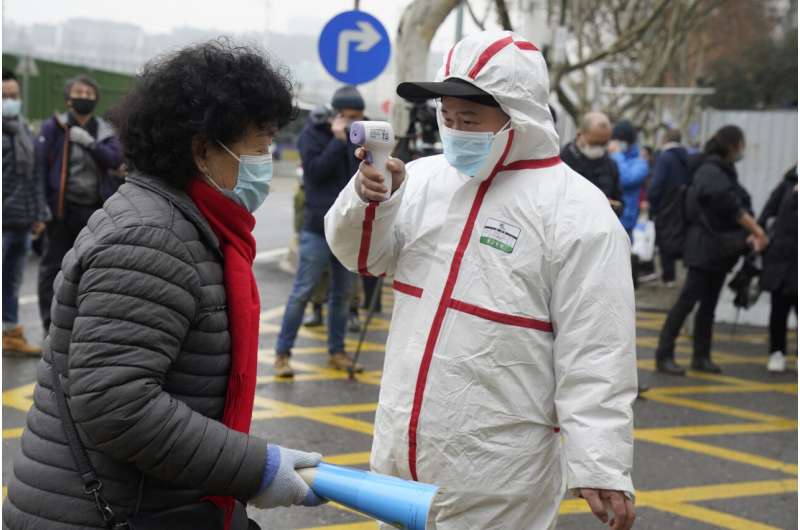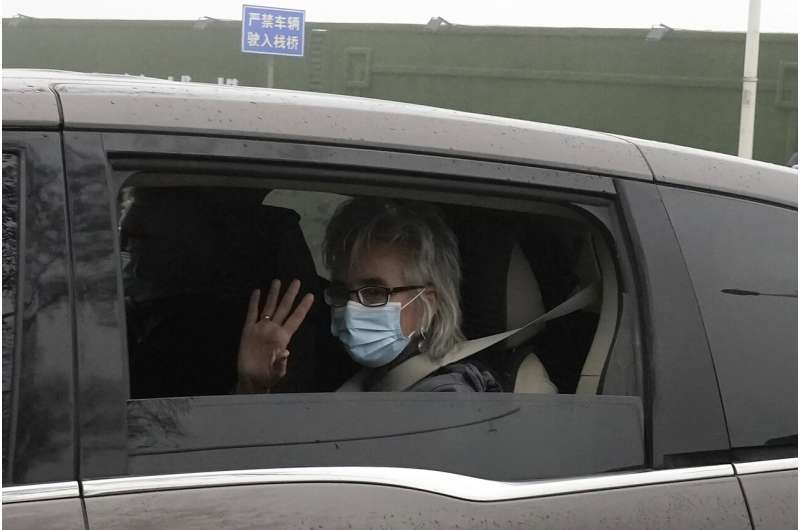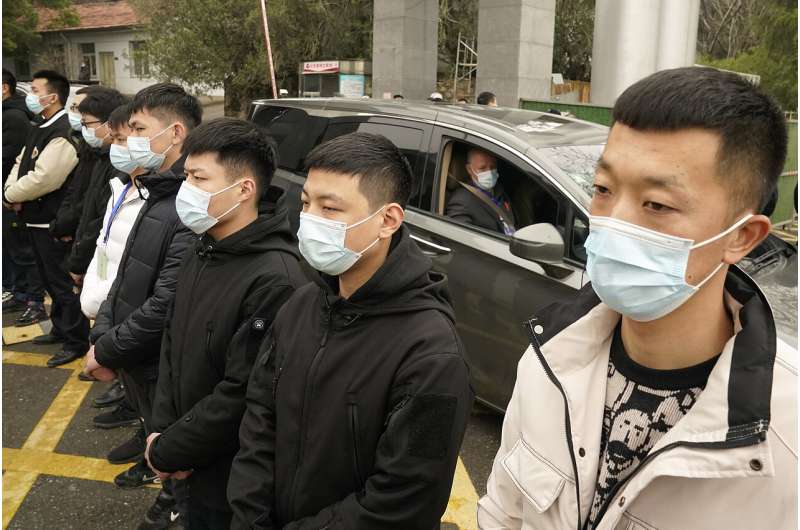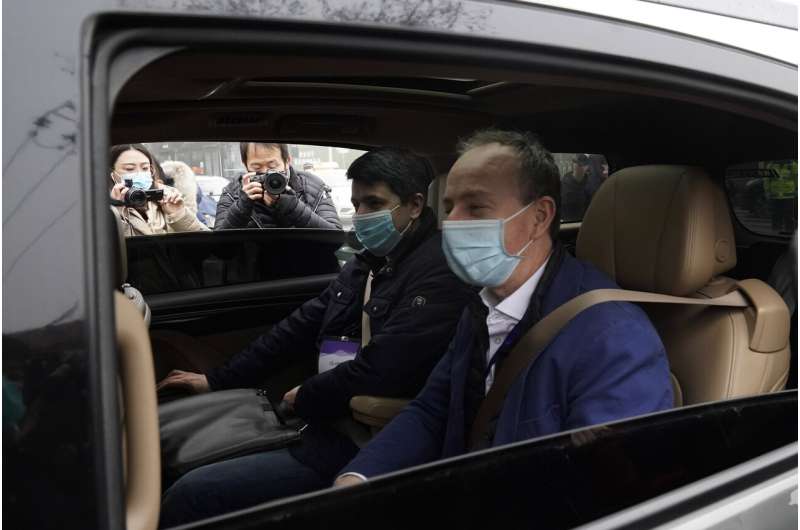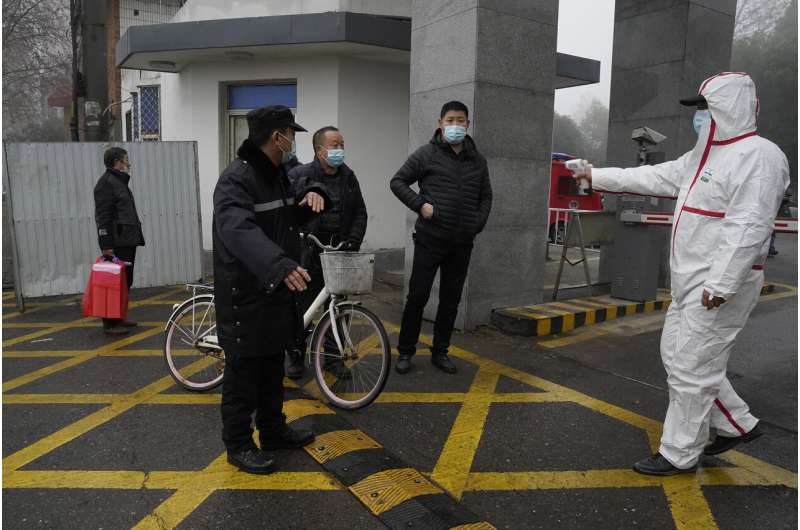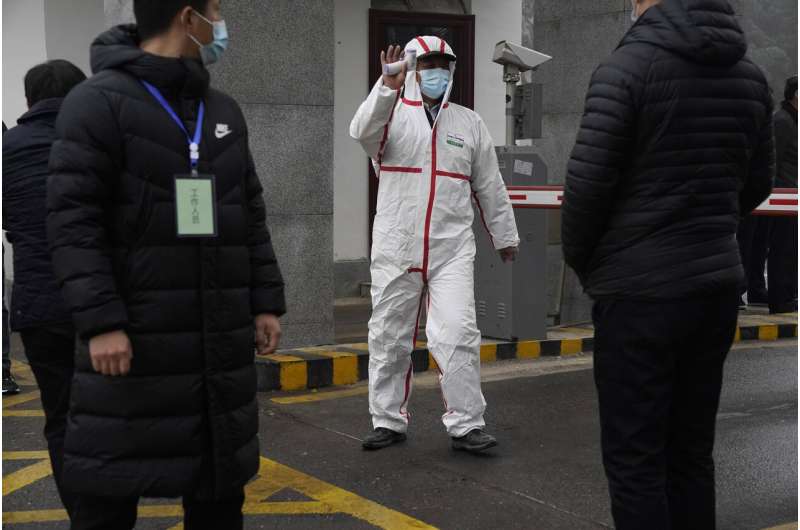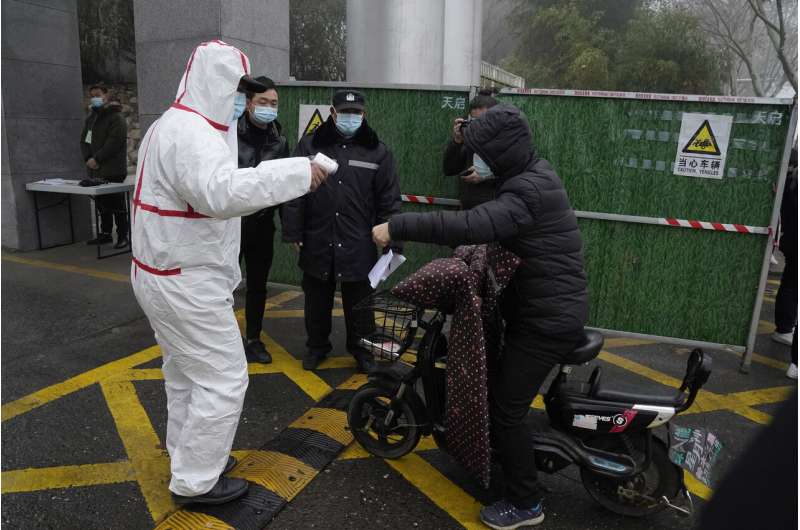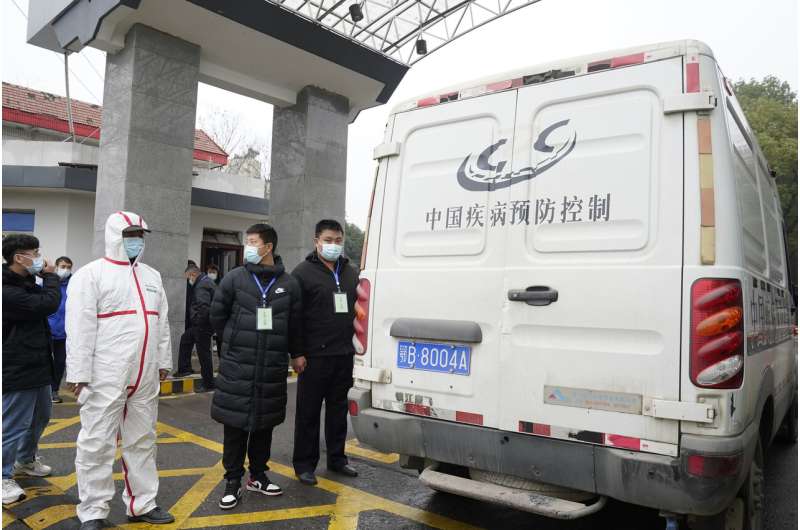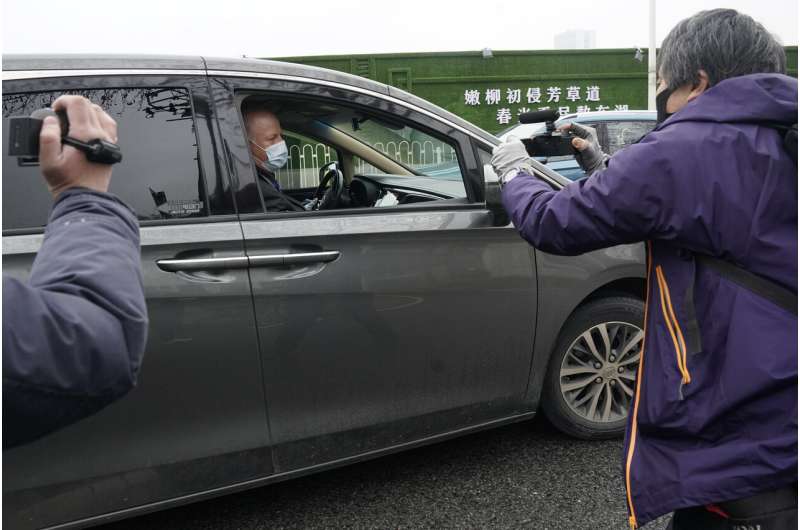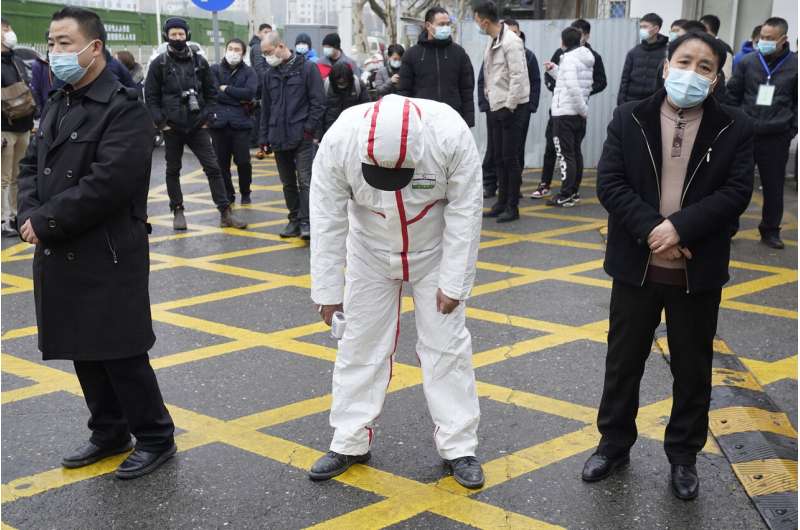Members of the World Health Organization team including Peter Daszak, left, Ken Maeda, right, and Vladimir Dedkov, second right, prepare to leave for a fourth day of field visits from their hotel in Wuhan in central China's Hubei province on Monday, Feb. 1, 2021. (AP Photo/Ng Han Guan)
A World Health Organization team investigating the origins of the coronavirus pandemic visited two disease control centers on Monday that had an early hand in managing the outbreak in the central Chinese city of Wuhan.
The WHO investigators arrived in Wuhan, the provincial capital, last month to look for clues and have visited hospitals and a seafood market where early cases were detected.
The team on Monday visited both the Hubei Provincial Center for Disease Control and its Wuhan city office, amid tight Chinese controls on access to information about the virus.
China has sought to avoid blame for alleged missteps in its early response to the outbreak, while promoting alternative theories that the virus originated elsewhere and may even have been brought to Wuhan from outside the country.
Following the visit to the provincial center, team member Peter Daszak told reporters it had been a "really good meeting, really important." No other details were given.
The evidence the team assembles will add to what is expected to be a years-long quest for answers. Pinning down an outbreak's animal sources requires massive amounts of research, including taking animal samples, genetic analysis and epidemiological studies.
In Geneva, WHO officials pushed back Monday against suggestions China is being less than forthcoming about how the pandemic started.
From right, Dominic Dwyer and Peter Ben Embarek of the World Health Organization team prepare to leave for a fourth day of field visits from their hotel in Wuhan in central China's Hubei province on Monday, Feb. 1, 2021. (AP Photo/Ng Han Guan)
At a press briefing, WHO's COVID-19 technical lead Maria Van Kerkhove said the team has plans to visit the Wuhan Institute of Virology, among other sites.
"The more detail you have on the ground, the more questions you have," she said. "The team will follow the information. They will follow the science and continue to ask questions and analyze data." Van Kerkhove said it would be up to team members to decide what other field visits were necessary, although China must approve the mission's ultimate agenda.
Dr. Michael Ryan, WHO's emergencies chief, said WHO was continuing to ask for more data and said anyone with information about how the pandemic started should share it with the organization.
"We are in the field with experts from 10 countries looking to find the answers. If you have the answers, if you think you have some answers, please let us know," he said. He dismissed critics who said any report from the mission would be incomplete and said the team "deserves the support of the international community."
-
A worker in protective overalls takes the temperature of a woman entering the Hubei Center for Disease Control and Prevention as the World Health Organization team makes a field visit in Wuhan in central China's Hubei province on Monday, Feb. 1, 2021. A World Health Organization team investigating the origins of the coronavirus pandemic visited a provincial disease control center that had an early hand in managing the outbreak. (AP Photo/Ng Han Guan)
-
Marion Koopmans of a World Health Organization team arrives at the Hubei Center for Disease Control and Prevention in Wuhan in central China's Hubei province Monday, Feb. 1, 2021. The WHO mission team investigating the origins of the coronavirus pandemic in Wuhan. (AP Photo/Ng Han Guan)
-
Peter Daszak of the World Health Organization leaves in a car past a row of security personnel at the Hubei Center for Disease Control and Prevention after a field visit in Wuhan in central China's Hubei province on Monday, Feb. 1, 2021. (AP Photo/Ng Han Guan)
-
Members of a World Health Organization team arrive at the Hubei Center for Disease Control and Prevention in Wuhan in central China's Hubei province Monday, Feb. 1, 2021. The WHO mission team investigating the origins of the coronavirus pandemic in Wuhan. (AP Photo/Ng Han Guan)
-
A worker in protective gear holds up a thermometer at the entrance to the Hubei Center for Disease Control and Prevention where a World Health Organization team is making a field visit in Wuhan in central China's Hubei province Monday, Feb. 1, 2021. The WHO mission team investigating the origins of the coronavirus pandemic in Wuhan. (AP Photo/Ng Han Guan)
-
Marion Koopmans of a World Health Organization team arrives at the Hubei Center for Disease Control and Prevention in Wuhan in central China's Hubei province Monday, Feb. 1, 2021. The WHO mission team investigating the origins of the coronavirus pandemic in Wuhan. (AP Photo/Ng Han Guan)
-
A worker in protective gear checks the temperature of a visitor at the entrance to the Hubei Center for Disease Control and Prevention where a World Health Organization team is making a field visit in Wuhan in central China's Hubei province Monday, Feb. 1, 2021. The WHO mission team investigating the origins of the coronavirus pandemic in Wuhan. (AP Photo/Ng Han Guan)
-
A van from the Hubei Center for Disease Control and Prevention enters the compound as the World Health Organization team makes a field visit in Wuhan in central China's Hubei province on Monday, Feb. 1, 2021. A World Health Organization team investigating the origins of the coronavirus pandemic visited a provincial disease control center that had an early hand in managing the outbreak. (AP Photo/Ng Han Guan)
-
Peter Daszak of the World Health Organization leaves in a car from the Hubei Center for Disease Control and Prevention after a field visit in Wuhan in central China's Hubei province on Monday, Feb. 1, 2021. (AP Photo/Ng Han Guan)
-
A tired worker in protective overalls bends over to stretch at the entrance of the Hubei Center for Disease Control and Prevention as the World Health Organization team makes a field visit in Wuhan in central China's Hubei province on Monday, Feb. 1, 2021. (AP Photo/Ng Han Guan)
China has largely curbed domestic transmission through strict testing and contact tracing. Mask wearing in public is observed almost universally and lockdowns are routinely imposed on communities and even entire cities where cases are detected. The latest outbreaks have been mostly in the frigid northeast, with 33 new cases reported nationally Monday in three provinces.
Despite that, China recorded more than 2,000 new domestic cases of COVID-19 in January, the highest monthly total since the final phase of the initial outbreak in Wuhan last March. Two people died of the disease in January, the first reported COVID-19 deaths in China in several months.
Schools have gone online and travel has been drastically cut during this month's Lunar New Year holiday, with the government offering incentives for people to stay put during the most important time for family gatherings across the vast nation.
© 2021 The Associated Press. All rights reserved. This material may not be published, broadcast, rewritten or redistributed without permission.
